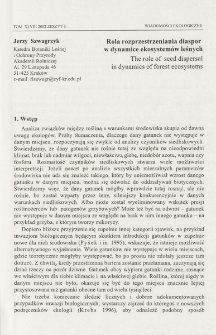- Search in all Repository
- Literature and maps
- Archeology
- Mills database
- Natural sciences
Advanced search
Advanced search
Advanced search
Advanced search
Advanced search

Object
Title: Rola rozprzestrzeniania diaspor w dynamice ekosystemów leśnych
Subtitle:
Rozprzestrzenianie diaspor ; Role of seed dispersal in dynamics of forest ecosysytems
Contributor:
Polska Akademia Nauk. Instytut Ekologii
Publisher:
Oficyna Wydawnicza Instytut Ekologii PAN
Place of publishing:
Description:
Type of object:
Abstract:
A hidden assumption that plants in generał, and trees in particular, are not significantly limited by their dispersal abilities persisted for a long time in ecological literaturę, and especially in papers concerning plant succession. The older models of forest dynamics (like JABOWA or FORET) usually assumed, that all species present in a regional species pool are also present in each simulated forest patch. However, in recent years there has been an increasing evidence which supports the opposite view - that dispersal abilities of trees strongly influence their population dynamics. A commonly observed trade-off between the competitive ability and mean dispersal distance can be considered one of the main mechanisms preventing exclusion of competitively weaker species and maintaining tree species diversity in forest stands. The morę recent models of forest dynamics (like SORTIE) tend to include the dispersal limitations into their theoretical framework. However, quantitative analysis and modelling of spatial distribution of seeds is a complicated task. The spatial distribution of seed densities around the stem of a parent tree - so- -called ”seed shadows” - used to be modelled by employing several dispersal functions (like log-normal, exponential, etc.). However, these functions were unable to simulate the dispersal of a smali fraction of seeds at very large distances. Recently, the so-called ”fat-tailed” distributions are being used for a morę realistic modelling of seed dispersal. They allow a smali fraction of seeds to be transported at very large distances, despite the fact, that majority of seeds fali close to the stem of the parent tree. The ”fat-tailed” distributions has been also employed in analyzing the patterns of tree migrations during the Holocene. Using the fat-tailed distributions allows to simulate tree migration in a morę realistic way and to overcome the so-called Reid*s paradox; that the actual rates of tree migration were several times higher than the estimates based upon the so-called ”ecological step”. The results of employing "fat-tailed” distributions for modelling tree migrations are intriguing: among them are the exponential increase of the ratę of population spread, and the fact, that species distributions are in most cases not uniform, but consist of several larger or smaller patches, as well as "islands" located far beyond the limits of the main area of a given species.
Relation:
Volume:
Issue:
Start page:
End page:
Detailed Resource Type:
Resource Identifier:
oai:rcin.org.pl:229275 ; 0013-2969
Source:
MiIZ PAN, call no. P.3259 ; click here to follow the link
Language:
Language of abstract:
Rights:
Creative Commons Attribution BY 3.0 PL license
Terms of use:
Copyright-protected material. [CC BY 3.0 PL] May be used within the scope specified in Creative Commons Attribution BY 3.0 PL license, full text available at: ; -
Digitizing institution:
Museum and Institute of Zoology of the Polish Academy of Sciences
Original in:
Library of the Museum and Institute of Zoology of the Polish Academy of Sciences
Projects co-financed by:
Access:
Object collections:
- Repozytorium Cyfrowe Instytutów Naukowych > Kolekcje Partnerów > Muzeum i Instytut Zoologii PAN > Czasopisma
- Repozytorium Cyfrowe Instytutów Naukowych > Piśmiennictwo > Czasopisma/Artykuły
Last modified:
Feb 4, 2025
In our library since:
Oct 29, 2021
Number of object content downloads / hits:
153
All available object's versions:
https://rcin.org.pl./publication/173778
Show description in RDF format:
Show description in RDFa format:
Show description in OAI-PMH format:
| Edition name | Date |
|---|---|
| Z. 3. Rola rozprzestrzeniania diaspor w dynamice ekosystemów leśnych / Szwagrzyk J. | Feb 4, 2025 |
Objects Similar
Szwagrzyk, Jerzy
Szwagrzyk, Jerzy
Szwagrzyk, Jerzy
Kaczka, Ryszard J. Czajka, Barbara Łajczak, Adam Szwagrzyk, Jerzy Nicia, Paweł
Kozłowska, Anna (1948– )
Diehl, Barbara

 INSTYTUT ARCHEOLOGII I ETNOLOGII POLSKIEJ AKADEMII NAUK
INSTYTUT ARCHEOLOGII I ETNOLOGII POLSKIEJ AKADEMII NAUK
 INSTYTUT BADAŃ LITERACKICH POLSKIEJ AKADEMII NAUK
INSTYTUT BADAŃ LITERACKICH POLSKIEJ AKADEMII NAUK
 INSTYTUT BADAWCZY LEŚNICTWA
INSTYTUT BADAWCZY LEŚNICTWA
 INSTYTUT BIOLOGII DOŚWIADCZALNEJ IM. MARCELEGO NENCKIEGO POLSKIEJ AKADEMII NAUK
INSTYTUT BIOLOGII DOŚWIADCZALNEJ IM. MARCELEGO NENCKIEGO POLSKIEJ AKADEMII NAUK
 INSTYTUT BIOLOGII SSAKÓW POLSKIEJ AKADEMII NAUK
INSTYTUT BIOLOGII SSAKÓW POLSKIEJ AKADEMII NAUK
 INSTYTUT CHEMII FIZYCZNEJ PAN
INSTYTUT CHEMII FIZYCZNEJ PAN
 INSTYTUT CHEMII ORGANICZNEJ PAN
INSTYTUT CHEMII ORGANICZNEJ PAN
 INSTYTUT FILOZOFII I SOCJOLOGII PAN
INSTYTUT FILOZOFII I SOCJOLOGII PAN
 INSTYTUT GEOGRAFII I PRZESTRZENNEGO ZAGOSPODAROWANIA PAN
INSTYTUT GEOGRAFII I PRZESTRZENNEGO ZAGOSPODAROWANIA PAN
 INSTYTUT HISTORII im. TADEUSZA MANTEUFFLA POLSKIEJ AKADEMII NAUK
INSTYTUT HISTORII im. TADEUSZA MANTEUFFLA POLSKIEJ AKADEMII NAUK
 INSTYTUT JĘZYKA POLSKIEGO POLSKIEJ AKADEMII NAUK
INSTYTUT JĘZYKA POLSKIEGO POLSKIEJ AKADEMII NAUK
 INSTYTUT MATEMATYCZNY PAN
INSTYTUT MATEMATYCZNY PAN
 INSTYTUT MEDYCYNY DOŚWIADCZALNEJ I KLINICZNEJ IM.MIROSŁAWA MOSSAKOWSKIEGO POLSKIEJ AKADEMII NAUK
INSTYTUT MEDYCYNY DOŚWIADCZALNEJ I KLINICZNEJ IM.MIROSŁAWA MOSSAKOWSKIEGO POLSKIEJ AKADEMII NAUK
 INSTYTUT PODSTAWOWYCH PROBLEMÓW TECHNIKI PAN
INSTYTUT PODSTAWOWYCH PROBLEMÓW TECHNIKI PAN
 INSTYTUT SLAWISTYKI PAN
INSTYTUT SLAWISTYKI PAN
 SIEĆ BADAWCZA ŁUKASIEWICZ - INSTYTUT TECHNOLOGII MATERIAŁÓW ELEKTRONICZNYCH
SIEĆ BADAWCZA ŁUKASIEWICZ - INSTYTUT TECHNOLOGII MATERIAŁÓW ELEKTRONICZNYCH
 MUZEUM I INSTYTUT ZOOLOGII POLSKIEJ AKADEMII NAUK
MUZEUM I INSTYTUT ZOOLOGII POLSKIEJ AKADEMII NAUK
 INSTYTUT BADAŃ SYSTEMOWYCH PAN
INSTYTUT BADAŃ SYSTEMOWYCH PAN
 INSTYTUT BOTANIKI IM. WŁADYSŁAWA SZAFERA POLSKIEJ AKADEMII NAUK
INSTYTUT BOTANIKI IM. WŁADYSŁAWA SZAFERA POLSKIEJ AKADEMII NAUK




































